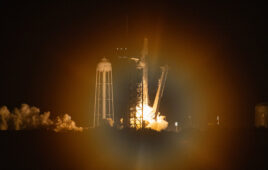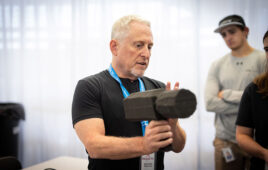
CubeLab systems. Credit: Space Tango
For astronauts, microgravity is a challenge that makes it harder to do even the most basic tasks like eating, walking and sleeping.
But for scientists, microgravity can be a powerful tool—one more should be taking advantage of, said Twyman Clements, the co-founder and CEO of Space Tango, a startup that specializes in designing complex autonomous systems for use in research and manufacturing in space.
“What we are doing is using microgravity in space as an asset,” said Clements in an interview with R&D Magazine. “I think a lot of the science that is happening in space has been about, ‘let’s test x,y,z and see what happens.’ What we are trying to get our customers to think about is how gravity is really one of the four forces of nature and how that can really impact their research and manufacturing efforts.”
Space Tango—which began operation in 2017—creates CubeLabs, individual units that house scientific experiments or manufacturing production systems. Each CubeLab is customized to the specific customer’s needs, with applications ranging across a wide variety of scientific and industrial disciplines. The CubeLabs are sent up to one of Space Tango’s two TangoLabs on the International Space Station (ISS), which can each hold up to 21 CubeLabs in a variety of potential configurations. They are designed to run autonomously and report data upon power up in TangoLabs, said Clements.
“We design all of our equipment to have very little astronaut intervention required,” he said. “One reason for that is that it allows us to control these modules that we send up, on the fly. We can change parameters, or even change the scientific experiment entirely, depending on how the module is designed. It gives us a lot of flexibility.”
Eight to 10 CubeLabs are sent to the ISS at one time, primarily via SpaceX flights. During their first year of operation in 2017, SpaceTango sent 30 payloads to the ISS.
They sent eight more payloads to the ISS in April 2018 on SpaceX CRS-14 and have plans for another eight CubeLabs to be sent in May and another 10 in June.
“SpaceTango is on four to five flights a year,” said Clements. “Experiments can go up and down once a quarter. Some missions we go up on don’t return, so we sometimes go up on one flight, and back down on another. We have a product design that allows us to iterate quickly with our customers to better their chances of success, and also really understand what they are working on.”
Microgravity applications
There are several key benefits of microgravity that scientists can take advantage of by using the CubeLabs, said Clements.
Within the material science field, microgravity offers purer crystallization, which can be utilized for protein crystallization, or for crystallizations for fiber optic cable production. It could also potentially be beneficial for silicon freeform production for silicon wafers.
Microgravity also creates an interesting chemistry environment for unique bonding, said Clements.
“We have customers we are working with that are looking to build active pharmaceutical ingredient reactors to mix certain fluids that are in certain regimens and see what bonding compounds they can produce,” he said.
Microgravity also changes in mass density, providing opportunities for manufacturing processes that could not be accomplished on Earth.
“You can have very heterogeneous mixtures, like sand and water, that would settle out on Earth that would be homogenous in microgravity,” he said. “Why that is important is that you might need to have extremely even bounding and layering for certain manufacturing processes. We have a customer that is building retinal implants and they need a still homogenous fluid for a long period of time for the layering to occur evenly to create their end product.”
Biology is another area where microgravity can be an excellent tool, said Clements.
“Biological systems really respond much differently to the stresses of microgravity, particularly epigenetically, and so we’ve been doing batch cell culturing on orbit and looking at a number of different studies in the biological area.”
There really are no limits to what can be studied in microgravity. SpaceTango’s most recent flight, which launched on April 2nd, featured a wide variety of scientific experiments, including an experiment looking at growing barley in microgravity led by beer company Anheuser-Busch, an experiment assessing the behavior of heat and humidity in microgravity, and an atomic clock study looking at the time dilation effect according to Einstein’s theories.
But the goal of Space Tango is not just to utilize microgravity for research efforts, said Clements.
“Our longterm focus is really working with customers to find use cases where you are manufacturing products in orbit and bringing them back for use on the planet,” he said. “Microgravity is really just one part of the manufacturing process. As a company, we are interested in not just focusing on research for researches sake, but really moving that research into manufacturing.”
Manufacturing-focused customers have included those working on fiber optic cable production, semiconductor manufacturing, active pharmaceutical ingredient production, and stem cell manufacturing.
Productization
To make it easier for both researchers and manufacturers to achieve their microgravity goals, SpaceTango has started to productize its CubeLabs, offering standardize modules for specific applications with set prices. The first cohort of standardized CubeLabs featured eight modules, and SpaceTango plans to grow that to 20 to 24 by the end of 2018.
“One big thing that has held back space research is that it hasn’t been productized,” said Clements. “It is kind of in this blue ocean of opportunity and the way it is sold is, you tell us what you want and we will build it. That takes a lot of time and money.”
“What we are really trying to do is productize it so potential customers can look through our product book and say, I want the plant model that does this type of sequencing ect., and the price is listed and the timeline is listed,” he added.
Looking ahead
In the short to intermediate-term future Space Tango is working to grow its client base and come out with more standardized CubeLabs for additional fields. They also plan to expand their TangoLab facilities on the ISS. In the longterm, they are planning for a future that expands outside of the ISS.
“The TangoLab and the CubeLab are really our first generation of products,” he said. “We would also like to have ones that deal with a post-ISS future, which we are already working on. In the longterm, it is really looking at a number of designs and architectures for what really happens in a post ISS-word, in low Earth orbit when private space stations and other vessels start being built.”




